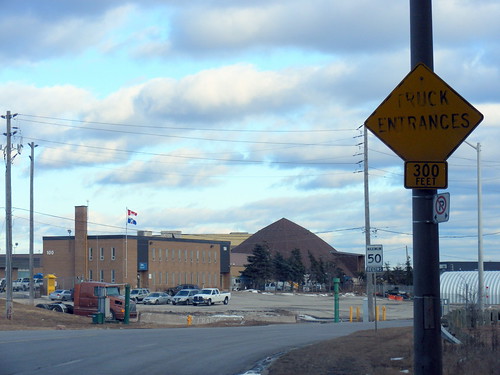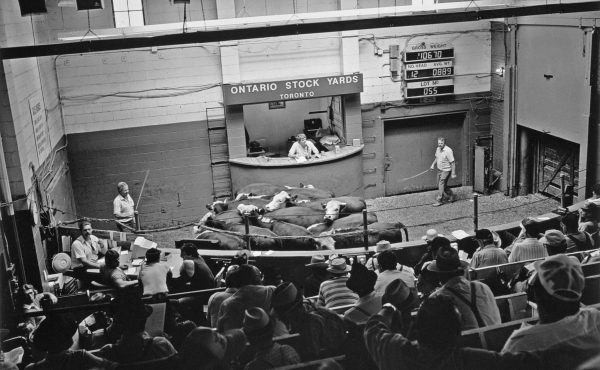 An old street sign in the foreground, with a newer metric speed limit sign and the Disco Road waste transfer station in the background.
An old street sign in the foreground, with a newer metric speed limit sign and the Disco Road waste transfer station in the background.
Disco Road, a four-lane industrial road in northwest Etobicoke, is perhaps Toronto’s most dated street name. Disco is most known as the name of a municipal waste-transfer station. These transfer stations are where garbage trucks unload their pick-ups for sorting and transfer to large tractor-trailers to the Green Lane landfill near St. Thomas, and where residents can unload their own loads for recycling and landfill. Other land uses on Disco Road include the Metro West Detention Centre (and ironically, across the street on Carlingview Drive is Lovat, a tunnel equipment company).
West of the waste transfer station, at the Highway 427 overpass, Disco Road turns into Goreway Drive as the four-lane road continues into Mississauga and heads north into Brampton and Caledon. But right upon entering Toronto from the Mississauga border, the driver is presented with perhaps the last non-metricized road sign in Toronto, maybe even one of the last in Canada. The sign warns of trucks entering and exiting Atwell Drive and the waste transfer station, but gives the warning distance in feet, not metres.
At the same time as the disco music craze, Canada began metricization under Prime Minister Pierre Trudeau and the Liberal government. At the time, the United States was also widely expected to follow suit (today, the US ranks only with Burma/Myanmar and Liberia in total non-metricization). Though while most measurements (liquid volumes, temperature, distances, air pressure, speeds) and (almost) all road signage is solely in metric, other measurements (weights, human heights, areas) and the interference of Mulroney’s Tories helped keep Canada in a in a strange, transitional phase. Somewhat like the outer reaches of Disco Road.




11 comments
If you noticed all the “For Lease” you could have also call it “The land that jobs forgot”.
Disco Road: Where you can still smell the funk!
I like the mish-mash here, and it reflects the personal-vs-official take on things. Our roads and our speedometers now say kilometres, so it makes sense to measure distances that way, and at the grocery store milk comes in litres and food often in grammes, so most of us have few problems with those. But I still cook cups and teaspooons, measure myself in feet and inches, and weigh myself in pounds. More and more each year, it seems.
I find it interesting that milk got retooled into litres and yogourt and sour cream into 500ml containers, but juice stayed in the strange 1.89 litre containers and butter is in 454-gramme pounds. And that houses are almost always measured in square feet but the land is often in hectares. And although it’s not technically metric, that Québec converted time to the 24h clock but Canada didn’t. (Similarly strange here is that renters get a 4 1/2 or 5 1/2 but buyers get 1 or 2 bedrooms.)
But don’t worry, we’re hardly alone in staying in a transitional phase — it goes on elsewhere an awful lot, too.
In the same way that Canada is bilingual in terms of English and French, we are also bilingual in terms of metric and imperial measurements.
Take the construction industry as an example — all public projects are designed using the metric system, but must be built of materials measured using the imperial system (many are made in the US, but even the Canadian-made materials are destined for the American market). 1220mm x 2440mm ceiling tiles anyone?
There’s still some pre-metric signage left over in Toronto — for example, there are two “low bridge” signs on northbound Coxwell at the CN overpass north of Gerrard… I’m pretty sure I’ve seen others as well but that’s the example that specifically comes to mind.
I have also seen a number of MAXIMUM 40 signs that were re-used pre-metric MAXIMUM 25 signs, where the 25 is visible underneath the metric overlay.
I hope the intention of this article is NOT to have government spend more money on signs that are already adequate.
Such a trivial matter – leave it alone!
The reason homes are still measured in square feet is because they’re still built that way.
You want a haven for conventional units? Try a lumberyard or home improvement store – it’s all feet and inches, with nearly no exceptions.
Not metric but an unsung old-school street-sign landmark: the black NO U TURN sign on Bay southbound by Nathan Phillips Square. If it ain’t broke, don’t replace it…
Speaking of odd signs, anyone know why the roads within the Shops at Don Mills have a 17 km/h speed limit? (When I saw it, I thought it might be an imperial thing, but 10 mph is much closer to 16 km/h.)
I seem to recall that the Disco in Disco Road predates the musical genre and may have been an acronym for some industrial business. Anyone know?
We have an interesting mish-mash of imperial and metric. Our building code is fully metric, but uses values that are imperial based, such as 400 mm and 600 mm on-centre spacing of studs (16″ and 24″). When we designed our home, span tables are all in metric, so the imperial dimensions had to be converted to determine the correct steel beam size. The beam size is then specified in metric nomenclature, which enables on to determine the beam’s mass in kilograms, but pricing it required conversion back to pounds because that is how suppliers price it!
When researching the location for the house, I had to go to the town to check sewer location drawings, and when the clerk brought out the old drawings, he admitted he couldn’t read them as they were in feet and inches. Fortunately, I went to school in the days when we learned both. Even so, some things I am now pretty well all metric, and some things not. Temperatures in weather forecasts need to be in metric for me to not have to stop and think about them, but when cooking, Celsius oven temperatures have me lost.
Our railways still work in miles and miles-per-hour for their rules and employee timetables, even though VIA Rail publishes public timetables that have kilometre distances between stations.